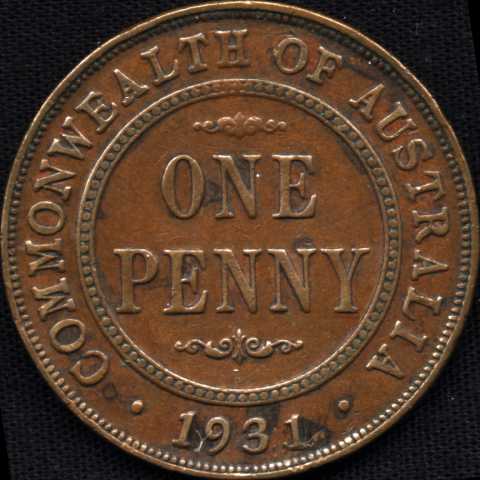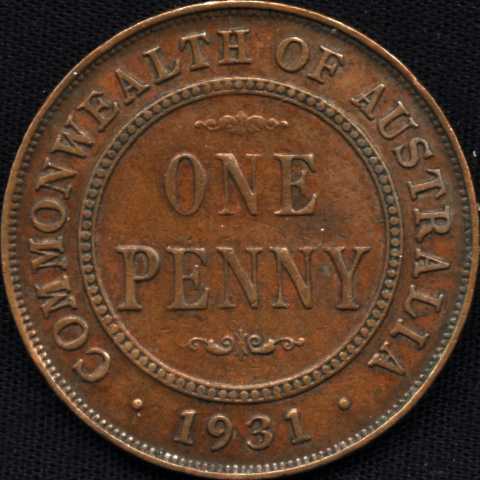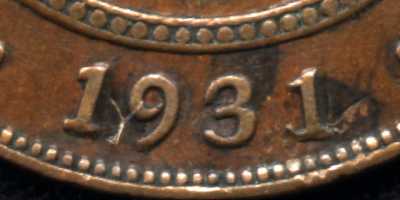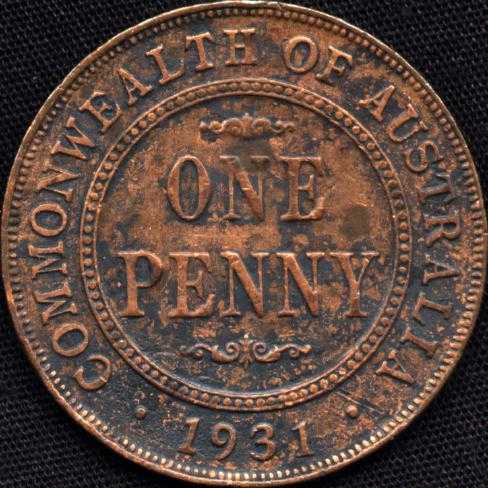Australian pennies dated 1931 were minted in Melbourne using two obverse and
two reverse dies for a total of four combinations. The coins with the London reverse
have a "misaligned 1" in the date (see picture below).
The 1931 penny had a fairly low mintage. According to Melbourne Branch Mint records
only 494,400 pennies were struck in that year. (Of those a few were dated 1930.)
Reverses

|
P31M.xA
This is the London reverse with 174 rim denticles.
All 1931 pennies struck with this reverse have the second 1 in the date "misaligned"
and the last four letters in AUSTRALIA have the
AL aligned with rim denticles and IA aligned with gaps between denticles.
|

|
P31M.xB
This is the Birmingham reverse with 177 rim denticles.
It has a date with the final 1 in the "normal" position and the last four
letters in AUSTRALIA have AL aligned with gaps
between rim denticles and IA aligned with denticles.
|
Enlargements of the date

|
P31M.xA
Date on the London reverse showing the final 1 "misaligned".
|

|
P31M.xB
Date on the Birmingham reverse with the final 1 in a "normal" position.
|
The Calcutta obverse is rare but the London reverse (misaligned 1) is common.
What is really rare is the combination of the London reverse and the Calcutta obverse.
In "The Coins and Tokens of British Oceania" (5th ed, 1971) Robert Clarke2
says:
The author has found the misaligned 1 variety to be slightly more plentiful than
the normal date. In an examination of 460 misaligned 1 coins only 2 with the Calcutta
die obverse were found. The only other penny to approach this ratio of rarity is
the 1915 misaligned 5 which was found once in 180 coins of this date and mint.
John Dean1 said that only 6 specimens (of P31M.2A) had been reported.
The number in existence was probably quite a lot higher but by now many of those
will have been lost. Excluding those reported by Clarke, I know of just three specimens.
Why should the 2A variety be so extraordinarily rare? I suspect that the Calcutta
dies were used during the latter part of the experiments which generated the 1930 pennies before the (Melbourne) Mint decided to use the
London die exclusively. The rare 1931 pennies struck with the Calcutta die represent
the last occasion on which the Calcutta die was used for Australian pennnies.
P31M.2A really exists

|
|

|
|
[ Home Page | Pennies
| Australian coins ]
Visitors
Most recent revision: 16th March 2001 - added picture of P31M.2A
Copyright ©2000, 2001 Triton Technologies International Ltd, all rights
reserved.





